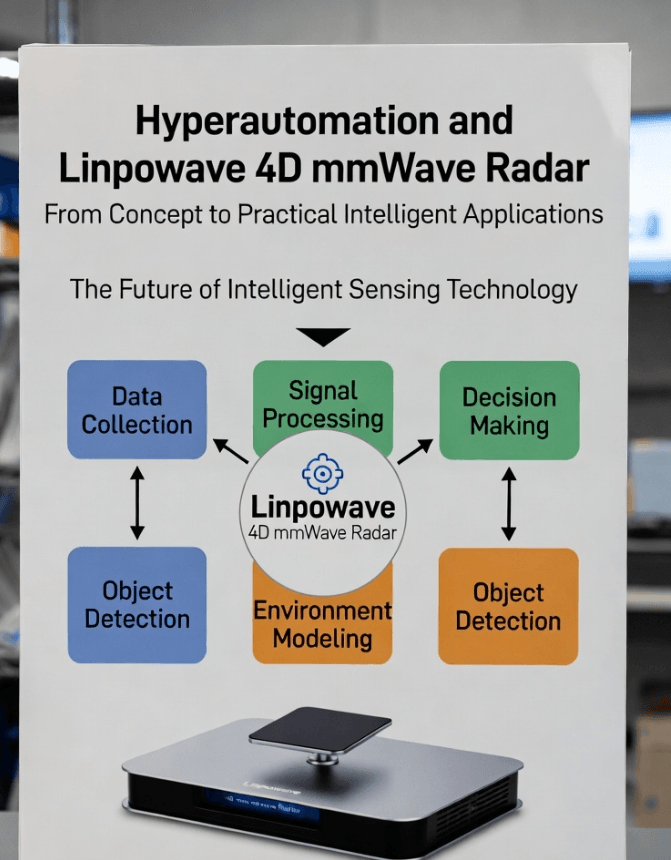1. Introduction: Dual Drivers in the Era of Intelligent Systems
By 2025, the deep integration of artificial intelligence (AI), the Internet of Things (IoT), and edge computing is driving enterprise intelligent practices from isolated automation toward end-to-end Hyperautomation. Hyperautomation extends beyond simple task automation, leveraging RPA (Robotic Process Automation), AI, machine learning (ML), and low-code/no-code platforms to achieve comprehensive optimization and adaptive decision-making across business processes. According to Gartner’s Emerging Technology Radar, Hyperautomation has become a key trend in enhancing efficiency and reliability across security, manufacturing, and transportation sectors.
Complementing this trend is the advancement of sensor technology. Linpowave’s 4D mmWave Radar provides high-resolution, all-weather environmental perception, generating high-density point cloud data in four dimensions—distance, azimuth, elevation, and velocity—serving as critical input for Hyperautomation systems. Detailed product information can be found on Linpowave’s official product page. This article systematically examines the integration path, technical principles, and real-world applications of Hyperautomation with 4D mmWave Radar, illustrating the transition from conceptual ideas to industrial-grade deployment.
2. Core Concept Analysis
2.1 Hyperautomation: The "Super Engine" of Intelligent Processes
Hyperautomation focuses on integrating multiple technologies to achieve end-to-end intelligent business processes. It surpasses traditional automation (e.g., scripted tasks) by emphasizing multi-technology collaboration and closed-loop optimization.
Key Technology Components:
-
RPA: Automates high-frequency repetitive tasks, such as data entry and report generation. Tools like UiPath or Automation Anywhere are widely used in industry.
-
AI/ML: Supports predictive analytics, anomaly detection, and decision optimization. ML frameworks such as TensorFlow and PyTorch enable model development.
-
Process Mining: Identifies bottlenecks and improvement opportunities in workflows; see Celonis Process Mining for reference.
-
Digital Twins & Simulation Tools: Test process improvements in virtual environments (Siemens Digital Twin).
-
Low-code/No-code Platforms: Enable rapid development and iteration of automation workflows.
Advantages:
-
End-to-end automation reduces human intervention by over 70%.
-
Adaptive learning enables responsiveness to dynamic business environments.
-
Privacy-friendly, as non-visual data (e.g., radar point clouds) minimizes ethical risks.
Typical Applications:
-
Smart transportation and fleet management: real-time traffic monitoring, anomaly prediction, and automated scheduling.
-
Autonomous driving: environment perception, path planning, and collision warnings.
-
Cybersecurity: threat detection and automated containment (Darktrace AI Security).
Hyperautomation acts as an “intelligent brain,” transforming systems from reactive to proactive and optimized decision-making.
2.2 Linpowave 4D mmWave Radar: The “All-Weather Eye”
Linpowave (Ningbo Linpow Microstep Information Technology Co., Ltd.) specializes in the development of 4D mmWave Radar. Its core team comprises experts from Peking University, the Chinese Academy of Sciences, and Microsoft, holding more than ten patents covering radar algorithms, antenna array design, and edge processing technologies. The 4D radar extends traditional 3D radar by adding the velocity dimension, producing up to 20,000 high-density point cloud data points per second for comprehensive scene perception.
Technical Principles:
-
FMCW Radar: Frequency-modulated continuous-wave radar operating in the 60–80 GHz band.
-
MIMO Antenna Arrays: Multi-input multi-output arrays providing azimuth resolution <1° and elevation resolution <5°.
-
Detection range up to 350 meters, supporting multi-target tracking (vehicles, pedestrians, drones).
Key Advantages:
-
All-Weather Robustness: Penetrates rain, fog, dust, and low-light conditions; highly stable and cost-effective.
-
4D Imaging: Generates dynamic 3D maps with trajectory prediction, suitable for complex environments.
-
Diverse Product Lines:
-
V100: Forward sensing for vehicle ADAS
-
U300: Obstacle avoidance for drones
-
R Series: SLAM for industrial robots, all supporting edge AI integration (NVIDIA Jetson Edge AI)
-
The 4D radar provides high-quality, real-time data for Hyperautomation, ensuring accurate and timely decision-making. More product details are available at Linpowave 4D Radar Solutions.
3. Integration Path: From Perception to Intelligent Execution
The combination of Hyperautomation and Linpowave 4D Radar forms a closed-loop “perception-decision-execution” architecture:
-
Data Layer: 4D radar outputs abstract point cloud data, processed at the edge for noise filtering, target classification, and preliminary fusion.
-
Automation Layer: RPA automates data collection and workflow triggers; ML models fuse radar and IoT data to detect anomalies such as collision risks or path conflicts.
-
Intelligence Layer: AI drives decision-making, e.g., reinforcement learning optimizes path planning, while process mining analyzes historical data for continuous algorithm refinement.
Architecture Example:
Radar → Edge AI (NVIDIA Jetson) → Hyperautomation Platform (UiPath + TensorFlow) → Actuators (vehicles, drones, robots)
Challenges and Solutions:
-
Data Heterogeneity: Kalman filter-based pre-fusion unifies point cloud and IoT data, reducing latency to <10ms.
-
Real-Time Requirements: Edge processing minimizes cloud communication delays, ensuring reliable control and response.
4. Practical Applications: Multi-Scenario Intelligent Deployments
| Scenario | Linpowave Product | Hyperautomation Function | Metrics | Solution |
|---|---|---|---|---|
| Smart Transportation | V100 | Decision Fusion | Detection 350m, latency <10ms | All-weather redundancy |
| Drone Obstacle Avoidance | U300 | Adaptive Path Planning | Obstacle avoidance >95% | Glare penetration |
| Robot Collaboration | R Series | Multi-Robot Coordination | Point clouds 20,000/s | Dust robustness |
| Security & Monitoring | 60 GHz Indoor | Automated Anomaly Response | Privacy 100% | Non-contact sensing |
References in practice: DJI integration examples (DJI Developer), NVIDIA edge AI for robotics (NVIDIA Jetson).
4.1 Smart Transportation and ADAS
-
Implementation: V100 radar integrated with Hyperautomation enables adaptive cruise control (ACC) and forward collision warning (FCW).
-
Results: Detects multiple targets within 200m in fog; reduces accidents by ~40%; supports BVLOS operations.
-
Scale: Deployed in Southeast Asian smart agricultural vehicles and logistics fleets.
4.2 Drone and Robot Obstacle Avoidance
-
Implementation: U300 radar with Hyperautomation enables terrain-following drones and industrial robot path optimization.
-
Results: Obstacle avoidance accuracy >95%, supports SLAM, stable under smoke/dust conditions.
-
Scale: 80% deployment in industrial drones and AMRs; DJI and other companies conducted integration tests.
4.3 Smart Security and Health Monitoring
-
Implementation: 60 GHz indoor radar used for elderly care and smart building management; ML classifies human postures and RPA triggers alerts.
-
Results: Privacy-preserving (no image output), response time <1s.
-
Scale: Pilot projects in healthcare and public safety.
5. Future Outlook and Challenges
The integration of Hyperautomation and 4D mmWave Radar is accelerating the transition from concept validation to large-scale deployment. By 2030, the 4D radar market is projected to exceed USD 10 billion, with Hyperautomation adoption potentially reaching 60%. Key challenges include algorithm optimization (edge computing power consumption), standardization (multi-vendor system integration), and cross-platform data interfaces. Open-source platforms (ROS) and shared patents can accelerate iteration and industrialization.
Linpowave provides reliable perception, Hyperautomation provides intelligent execution, forming a safe, efficient, and scalable intelligent ecosystem applicable to autonomous driving, drones, industrial monitoring, and health applications.
6. Action Recommendations
-
Launch Small-Scale Pilots: Validate high-frequency, cross-system processes (6–12 weeks).
-
Data Integration: Integrate point cloud data with Hyperautomation platforms.
-
Quantify ROI: Measure outcomes via KPIs such as error rates, process cycle time, and labor savings.
-
Expand Deployment: Replicate pilot experience using modular components.
-
Technical Support: Seek Linpowave customized solutions or consulting services as needed.
7. FAQ
Q1: Which series is recommended for industrial liquid level monitoring?
A1: The Liquid Level Series is recommended; supports harsh environments and edge computing.
Q2: What is the typical duration of a Hyperautomation pilot?
A2: Typically 6–12 weeks, suitable for validating MVP and collecting business data.
Q3: How do Linpowave products integrate with low-code/RPA platforms?
A3: SDK and standard protocols (MQTT, HTTP, CAN, Ethernet) enable rapid integration with business process platforms.



